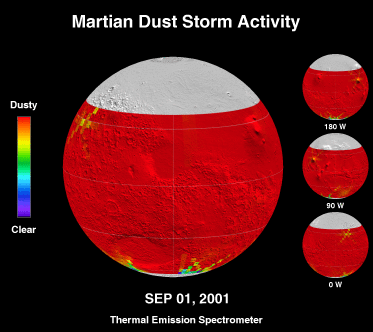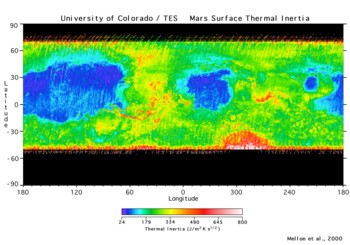Storm Cessation

|
|
Waning stages of 2001 storm
|
Once the dust is raised into the atmosphere, in can take months or even years for the atmosphere to clear. The Viking landers observed a persistent background dust opacity from a few tenths to 1.0 at visible wavelengths. Years later, subsequent microwave observations indicated that the background dust level had dropped significantly, cooling the atmosphere below both Mariner 9 and Viking observed temperatures (Kahn et al, 1992).
|
Thermal inertia map of Mars (click to enlarge)
|
The dust raised in global storms spreads over much of the planet and falls to the surface, changing the local surface albedo for weeks to years, depending on the location (Kahn et al, 1992). Thermal infrared spectral data can be used to derive surface thermal inertia (see map at left), a physical property dependent on grain size and induration. This allows some measure of the distribution of dust and the degree to which the grains are compacted or cemented (Mellon et al, 2000). In the case of dust-mantled regions, the degree of induration is likely to be related to the age of the surface and will affect its ability to act as a source in future dust storms. Together, thermal inertia and surface albedo changes provide an indication of areas of net removal and deposition of dust by storm activity.
In general, the thermal and albedo data as well as the analysis by Cantor et al (2001) of 1999 local and regional dust storms support earlier conclusions (e.g., Kahn et al, 1992) that the dust sources are predominantly in the low to mid southern latitudes and that dust sinks are located in high thermal inertia regions such as Tharsis, Arabia, and Elysium as well as the northern polar cap. Studies of planetary orbital evolution (e.g., Laskar and Robutel, 1993) indicate that Mars is in a chaotic orbital state with extreme variations in obliquity (0° to 60°) over about a 51,000 year period. It is thought that the polar laminae observed on Mars provide an indication of this, with ice layers of varying dust content perhaps related to a reversal of the cross-equatorial seasonal cycle and the source and sink locations.
Additional links:
ASU TES Dust Storm Movies
Hubble 1997 dust storm dissipation images
Mars Pathfinder home
Viking Lander data
Mars albedo map (telescopic)
Various other Mars maps (including albedo and thermal inertia derived from Viking data)
|
Cessation |
The Life Cycle of Martian Dust Storms
Planetary Atmospheres Final Project
by Than Putzig
